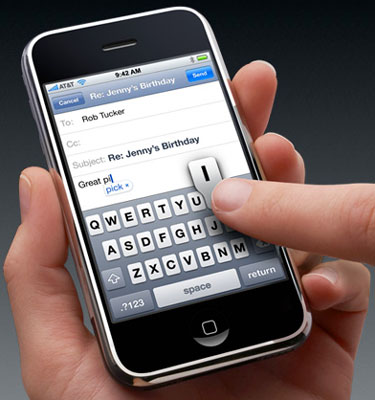Though the new design looks fantastic in renders on the Apple website, in the hand it feels cold and industrial. It lacks the subtle ergonomics of previous iPhone models and the brushed steel trim feels sharp against our much softer fingers. Speaking of fingers, be prepared to wipe maniacally at the fingerprints that accumulate not only on the touchscreen, but also across the glass backside of the new phone. People often buy thin plastic screen protectors for touchscreen phones, but we wouldn't be surprised to see thin plastic handset covers hit the market for the iPhone 4 before long.
Current iPhone users will find little else to coo over once they power up their latest gadget. As with the experience of buying a new Mac or PC, once you boot it up there is an inevitable disappointment to be greeted by the same old operating system as before. If you've downloaded the iOS 4 firmware for your 3G or 3GS then you'll find there are no surprises short of the new phone processing slightly faster.
The continental grip
In tennis, the continental grip is a standard racquet grip, which is excellent for return of serve, or so we've been told. If you hold the iPhone like this, however, you can expect a nasty shock. Yes, we're talking about the iPhone "death grip", and if you thought Apple would solve this issue before daring to release this phone in Australia then you'd be wrong — dead wrong.
The first thing we did with the iPhone 4 when we ripped the plastic off the milky white box was grab it in the death grip and watch for the signal bars to disappear. It takes about 30 seconds before the first bar drops, then the fall off is steady after that. But what does this all mean in real-world situations? It's one thing to watch signal bars come and go, but does this issue affect the way the phone operates?
This depends on where you use the phone. When we tested the phone in the city with strong network coverage, phone functionality remained fine even when the iPhone reported only one bar signal. We ran online speed tests to trial the death grip data throughput and we couldn't find any noticeable loss of speed. Though we did see wild fluctuations in results, we couldn't isolate this issue as being related to the design flaw. However, when we tested in an area of low network coverage, we saw a much more serious issue. Starting with two or three bars of signal the so-called death grip killed the phone's reception entirely and the iPhone continued to report "No Service" until we moved our hand. If you are someone who struggles for reception anyway we suggest you choose a different phone.

No comments:
Post a Comment